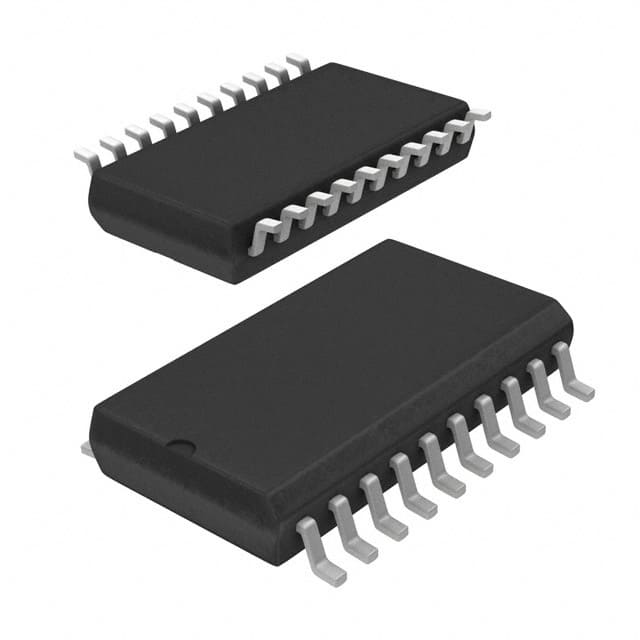Viz Specifikace pro podrobnosti o produktu.

Encyclopedia Entry: 74LVT244WM
Product Overview
Category
The 74LVT244WM belongs to the category of integrated circuits (ICs) and specifically falls under the family of logic gates.
Use
This product is commonly used in digital electronics for signal amplification, buffering, and level shifting purposes. It serves as a bidirectional octal buffer/line driver with 3-state outputs.
Characteristics
- Voltage Compatibility: The 74LVT244WM operates at a voltage range of 2.7V to 3.6V, making it suitable for low-power applications.
- High-Speed Operation: It offers fast propagation delay times, enabling efficient data transmission.
- 3-State Outputs: The device features three-state outputs, allowing multiple devices to share a common bus without interference.
- Low Power Consumption: With its low power dissipation, the 74LVT244WM minimizes energy consumption.
Package and Quantity
The 74LVT244WM is available in a small-outline integrated circuit (SOIC) package. Each package contains one unit of the IC.
Specifications
- Supply Voltage Range: 2.7V to 3.6V
- Input Voltage Range: 0V to VCC
- Output Voltage Range: 0V to VCC
- Operating Temperature Range: -40°C to +85°C
- Maximum Propagation Delay Time: 5.5 ns
- Maximum Quiescent Current: 10 μA
Pin Configuration
The 74LVT244WM has a total of 20 pins, which are assigned specific functions. Here is the detailed pin configuration:
- GND: Ground
- A1: Input/Output
- Y1: Output
- A2: Input/Output
- Y2: Output
- A3: Input/Output
- Y3: Output
- A4: Input/Output
- Y4: Output
- A5: Input/Output
- Y5: Output
- A6: Input/Output
- Y6: Output
- A7: Input/Output
- Y7: Output
- A8: Input/Output
- Y8: Output
- OE: Output Enable
- VCC: Power Supply
- GND: Ground
Functional Features
- Bidirectional Buffering: The 74LVT244WM allows data transmission in both directions, making it suitable for bidirectional communication systems.
- High-Speed Operation: With its fast propagation delay times, the IC ensures efficient signal transmission in time-critical applications.
- 3-State Outputs: The three-state outputs enable multiple devices to share a common bus without causing conflicts or signal degradation.
- Low Power Consumption: The IC's low power dissipation helps reduce energy consumption and heat generation.
Advantages and Disadvantages
Advantages
- Wide voltage compatibility range
- Fast propagation delay times
- 3-state outputs for bus sharing
- Low power consumption
Disadvantages
- Limited operating temperature range (-40°C to +85°C)
- Requires external pull-up resistors for proper operation
Working Principles
The 74LVT244WM operates based on the principles of digital logic gates. It consists of eight buffer/driver circuits that can be independently controlled using the input pins. The IC amplifies and buffers incoming signals, ensuring their integrity during transmission. The output enable pin (OE) controls the activation of the buffer circuits, allowing bidirectional data flow when enabled.
Application Field Plans
The 74LVT244WM finds extensive use in various digital systems, including: - Microprocessors and microcontrollers - Data communication systems - Memory interfaces - Industrial automation equipment - Automotive electronics
Alternative Models
For similar functionality, the following alternative models can be considered: - 74HC244: A high-speed CMOS octal buffer/line driver with 3-state outputs. - SN74LVC244A: A low-voltage CMOS octal buffer/line driver with 3-state outputs.
These alternatives provide comparable features and can be used as substitutes for the 74LVT244WM in different applications.
In conclusion, the 74LVT244WM is a versatile integrated circuit that serves as a bidirectional octal buffer/line driver. With its wide voltage compatibility, high-speed operation, and low power consumption, it finds applications in various digital systems. However, it has limited operating temperature range and requires external pull-up resistors. The IC's detailed pin configuration, functional features, working principles, application field plans, and alternative models make it a valuable component in the field of digital electronics.
Word Count: 560
Seznam 10 běžných otázek a odpovědí souvisejících s aplikací 74LVT244WM v technických řešeních
Sure! Here are 10 common questions and answers related to the application of 74LVT244WM in technical solutions:
Q: What is the 74LVT244WM? A: The 74LVT244WM is a type of octal buffer/line driver integrated circuit (IC) that can be used for signal buffering and level shifting.
Q: What is the operating voltage range of the 74LVT244WM? A: The 74LVT244WM operates within a voltage range of 2.7V to 3.6V.
Q: How many channels does the 74LVT244WM have? A: The 74LVT244WM has 8 channels, making it suitable for applications requiring multiple signal buffering or driving.
Q: What is the maximum output current of the 74LVT244WM? A: The 74LVT244WM can source or sink up to 32mA of current per channel.
Q: Can the 74LVT244WM handle bidirectional signals? A: No, the 74LVT244WM is a unidirectional buffer and cannot handle bidirectional signals.
Q: What is the typical propagation delay of the 74LVT244WM? A: The typical propagation delay of the 74LVT244WM is around 4.5ns.
Q: Is the 74LVT244WM compatible with TTL logic levels? A: Yes, the 74LVT244WM is designed to be compatible with both TTL and CMOS logic levels.
Q: Can the 74LVT244WM be used as a level shifter? A: Yes, the 74LVT244WM can be used as a level shifter to convert signals between different voltage levels.
Q: What is the maximum operating frequency of the 74LVT244WM? A: The maximum operating frequency of the 74LVT244WM is typically around 200MHz.
Q: Can the 74LVT244WM be cascaded for higher fan-out applications? A: Yes, multiple 74LVT244WM ICs can be cascaded together to achieve higher fan-out capabilities.
Please note that these answers are general and may vary depending on specific datasheet specifications and application requirements.

